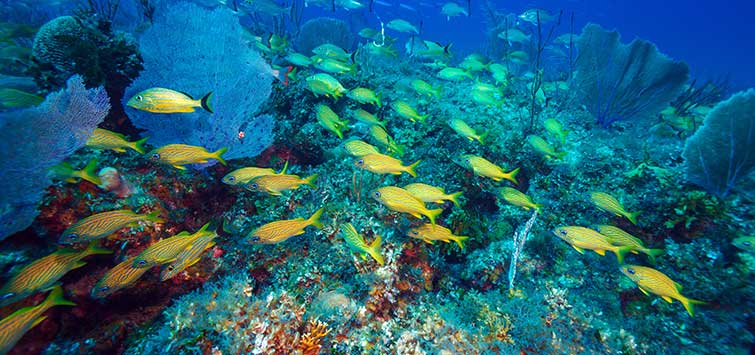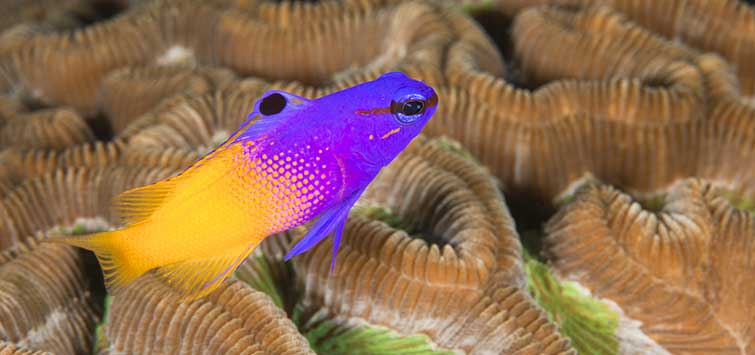Snorkeling in Cuba
Author: John Robertson
Playa Pesquero is a long tourist beach of beautiful white sand set in a protected bay on the northern coast of eastern Cuba. The area, with its shallow waters off the beach, is known for its excellent snorkeling conditions and abundance of fish that are endemic to the Caribbean Sea.
Arrival in Cuba
On my first day in Cuba, I discovered thatthe main reef was 100 yards (91 meters) from the shore and far too deep for snorkeling. The visibility closer to shore was poor, but that was due to the hot, breezy weather that—although enjoyed by sunbathers—raised the fine sand beneath the waves.
The water clarity varied by the hour and location. At times, visibility was less than 5 yards (4.5 meters), but often it was much better. I soon discovered that there was no need to venture out too far, as there were many wonderful fish close to shore.
The seascape at Playa Pesquero is very varied, ranging from wide expanses of white sand to large areas of flat rocks and boulders. There are also sections of large, isolated corals rising from a substrate of coral rubble. These zones extend for about 50 yards (46 meters) from the shore but are never much more than 6 feet (2 meters) deep.
Rocky Shallows
The shallowest waters, which measure less than 3 feet (one meter) in depth, are teeming with small fishes that include wrasses, damselfishes, blennies, and the juveniles of such species as grunts, surgeonfishes (tangs), and angelfishes.
Wide areas of flat white rock are covered with sediment and punctuated with craters. Many fish, particularly damsels that glitter in yellow and blue, take refuge underneath these flat slabs. The damsels tend to drive off the small surgeonfishes that compete for the algae resources, which thrive under the brilliant tropical sun. It’s very likely that the damsels had chosen these areas as spawning grounds.
Tricky Damsels
Aquarists know that this territorial nature makes damsels, despite their beauty, too feisty for many home aquariums. While I was snorkeling, I was unable to get a good photo of them. Whenever I got close to them, the tiny damsels would charge at my camera with lightning-fast speed and retreat just as quickly into a small hole or recess. Their determination and courage was remarkable as they attacked me over and over again, never tiring even as they drove off many other fishes.
Blennies and Wrasses
Several species of blenny make their homes in nooks and crannies, while small wrasses are constantly on the move, such as the striking blue heads (Thalassoma bifasciatum), which are like tiny torpedoes in perpetual motion. Many wrasses change dramatically as they grow. The intermediate form of the puddingwife wrasse (Halichoeres radiatus) is a lovely sight that does not deserve such an unflattering name.
Scorpionfish
There are plenty of amazingly camouflaged scorpionfish (Scorpaenidae spp.) lying in wait, and on one occasion, I almost put my hand on an adult specimen that was approximately 18 inches (46 cm) long. I am not sure if I was more shocked by the flashes of its boldly striped tail—which is normally hidden—or by its sudden burst of speed as it dashed away to settle a few yards away from me, becoming virtually invisible once more.
Gentle Bay
Venturing out a little further, I discovered large areas of patch reef that were 6 to 8 feet (2 to 2.5 meters) deep, with islands of large brain corals as well as fields of sea fans and gorgonians rising above a complex terrain of coral debris. Visibility, though still variable, was generally better than in the shallowest waters and at times reached 10 to 15 yards (9 to 14 meters).
This was the richest habitat, with the species seen in the shallows also in abundance here. Brilliant blue surgeons (Acanthurus coeruleus) and striped doctor fishes (Acanthurus chirurgus), with both species measuring up to a foot (30.5 cm) long, were joined by impressive yellow-tailed snappers (Ocyurus chrysurus) that reached 18 inches (46 cm) in length and an occasional shoal of 20 to 30 fish that appeared out of nowhere.
Do Not Feed
Many tourists unfortunately attract the fish with offerings of bread or bananas, and this caused them to follow me in hopes of receiving such treats from me. This is a bad practice, as these food items are not beneficial to a fish diet.
More Specimens
Tiny neon gobies (Elacatinus oceanops) offered cleaning services from the security of the projecting corals, while smaller groups of fluorescent blue chromis (Chromis cyanea) boldly glided above the corals. Shoals of various grunts (family Haemulon spp.)—French, blue-striped, and tomtate—and rosy red soldierfishes (Holocentridae) huddled close to cover. Coneys (Cephalopholis fulva) retreated at my every approach, and I spotted at least three species of morays sliding through the rocks and rubble to take cover under substantial coral structures. Wrasses cruise here too, including the lovely spanish hogfish (Bodianus rufus).
Angels and Lionfishes
Angelfishes are the stars of the Caribbean reefs, and there were stunning French angels (Pomacanthus paru) of all growth stages except adult to be seen. One individual was particularly bold and literally posed—showing me one side, then the other—so I could witness its striking bands of youth on glorious display. It also had subtle golden edges to every scale, the first signs of maturity.
There were also numerous rock beauties (Holacanthus tricolor) and an occasional juvenile queen angel (Holacanthus ciliaris), but I was disappointed that I didn’t encounter an adult French or queen angel.
The large number of lionfish (Pterois spp.) in the area was something I found disturbing. They were sheltering under many large rocks, usually two and three at a time. As beautiful as they are, lionfish—being native to the Indo Pacific oceans—have no place in this region.
I couldn’t detect which species they prey upon and if their presence is having a serious impact on populations of other fishes. I saw many grunts, surgeons, and wrasses that didn’t seem to be impacted. However, I didn’t notice a single cardinalfish, which led me to wonder if these nocturnal feeders are being depleted by the invading lionfish.
Deep Water
Swimming another 50 yards (46 meters), I reached the deeper waters. Dark rocks rose jagged and unpredictable from the pale sand below, like a mountain range on an alien planet. The visibility is generally better in the deeper water, but it’s not a good idea to be alone so far from shore.
The fauna here was similar to that of the previous zones, but the yellow-tailed snappers and shoals of surgeonfish were even more numerous. My wife went scuba diving nearby and reported sighting a 6-foot (2-meter)-long reef shark (Carcharhinus melanopterus) that appeared disinterested while gliding past her.
Large groupers, snappers, and stoplight parrotfish make this area interesting, but the vista of rocky outcrops encrusted with yellow barrel and red vase sponges are a more impressive attraction to many snorkelers.
Guardalavaca
The nearby resort of Guardalavaca offers another stunning white beach. A local dive master advised me to swim out 100 yards (91 meters) from one end of the beach. I crossed an area of sand, a large tract of sea grass, and a patch reef before I spotted several snorkelers.
The swim was well worth the effort. Despite being so far from the shore, the water was only 6 to 8 feet (2 to 2.5 meters) deep, and I was greeted by an amazing landscape of Acropora hulks, great skeletons spreading out like trees and encrusted with forests of sea fans. Visibility here was excellent, but these incredible structures were so large that the channels between them felt like alleyways between small buildings.
All the fishes I had seen at Playa Pesquero were here, too, as well as a few other species. A beautiful trunkfish (Lactophrys bicaudalis) was trying hard to evade the attention of a young remora that eventually gave up and tried to attach to my leg. A smaller species of trunkfish, adorned with exquisite spots, also hovered nearby.
Over the Sand
In total, my snorkeling allowed me to observe almost 90 species of fish in these various habitats of coral, rock, and deeper reef. In comparison, the sandy areas that divide up the structured locations can appear quiet and sterile—yet these areas too are worth a look.
One morning, I entered the water as the sun crept above the horizon. The conditions were calm as I made my way parallel to the beach, approximately 30 yards (27.5 meters) out over a sandy plain of perfect clarity.
A lonely tulip shell snail left its track in the soft substrate. Peacock soles blended into sand and rocky areas, changing color as swiftly as do squid. A group of bonefish were digging greedily for invertebrates such as white crabs and bristle worms, while in the distance, a trio of huge barracuda and a languid snapper warily moved away as I approached.
The Flying Gurnard
At that moment, I noticed the strangest-looking fish I’ve ever seen. It was a flying gurnard (Dactylopterus volitans), picking its way over the sand like a giant insect. It measured approximately a foot (30.5 cm) long, and despite having huge eyes, it appeared quite unconcerned that I was swimming down to take pictures of it.
The flying gurnard has amazing fins. Creeping as slowly as a tortoise over the sandy bottom, it literally walks, raising up on its ventral fins and forming a tripod with its tail as a stabilizer. Its large pectoral fins are in two sections that operate independently. The front part acts as a hand to scoop sand up to its mouth, rather than lowering its head. The back part spreads like enormous wings when the fish is disturbed. These huge fins serve merely to shock and deter predators.
The fish has a very stiff, ungainly appearance, with an armored head and bony plates on its body. It also has long spines rising from the back of the head, on both sides, and from the gill covers. I am not surprised that scientists cannot agree on where these amazing fish fit in the scheme of things. FishBase places the gurnards as a separate family, Dactylopteridae, within the Scorpaeniformes.
An Excellent Destination
I went to Cuba looking for something different, and it certainly did not disappoint. This is a poor country, but the people were very friendly, our hotel was good, and the Caribbean music was wonderful. The beautiful beach of Playa Pesquero provides an excellent location for sunbathing, swimming, salsa lessons, and snorkeling.

.png?h=595&iar=0&w=2781&hash=5FD5E69473BCC22199FBFA2FB71B6033)



